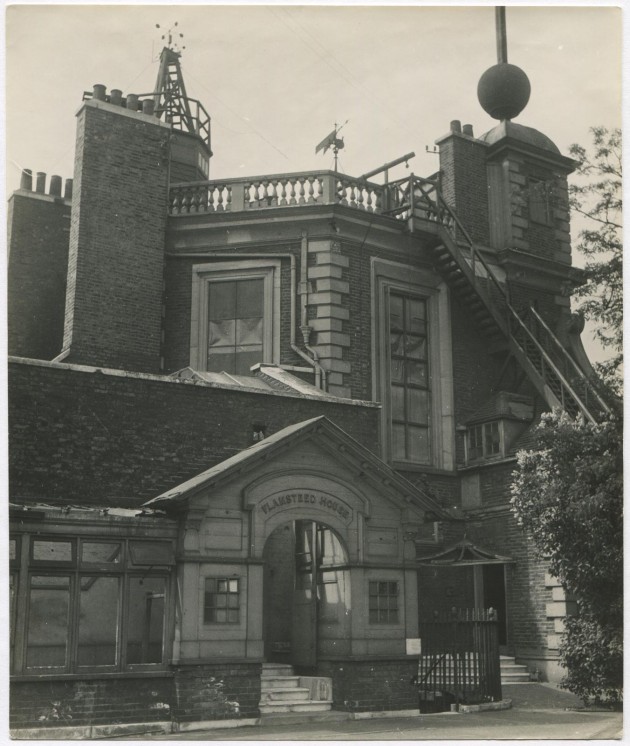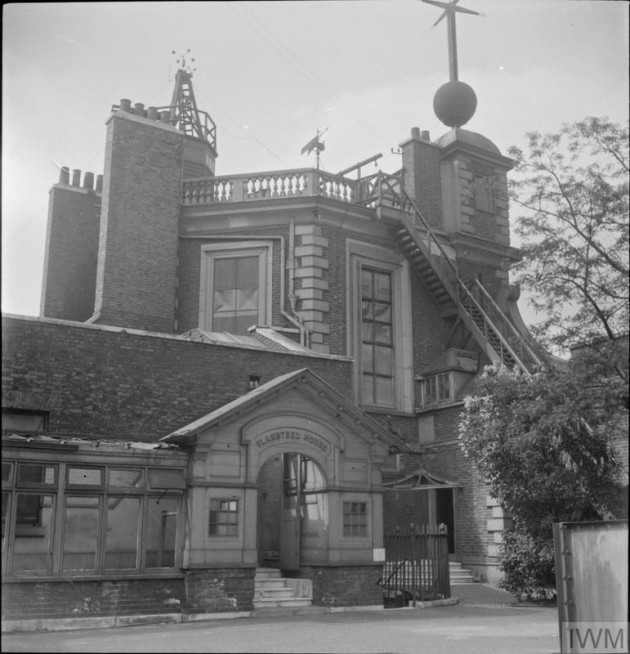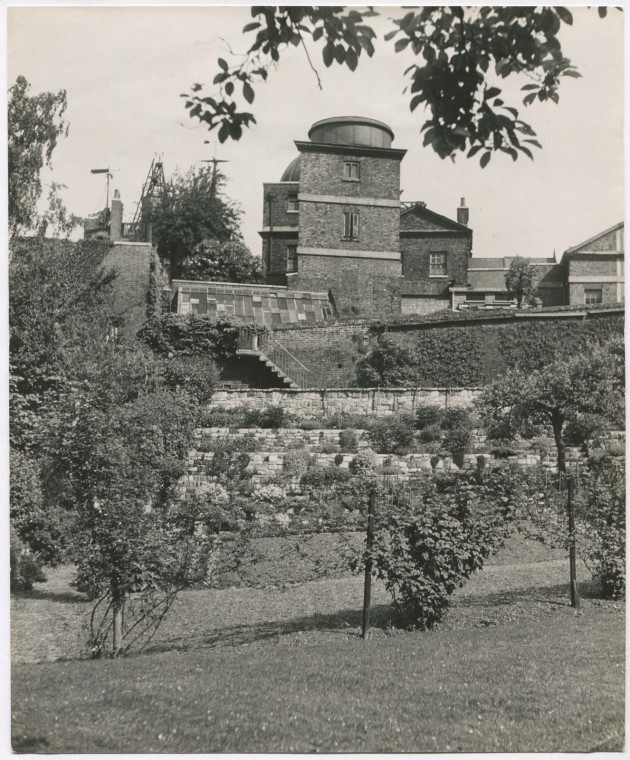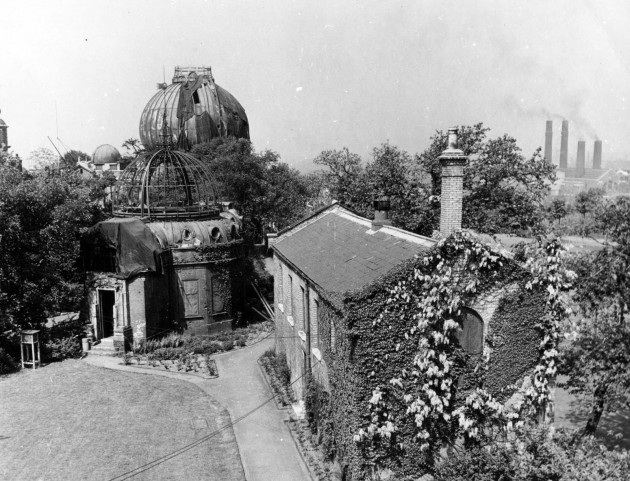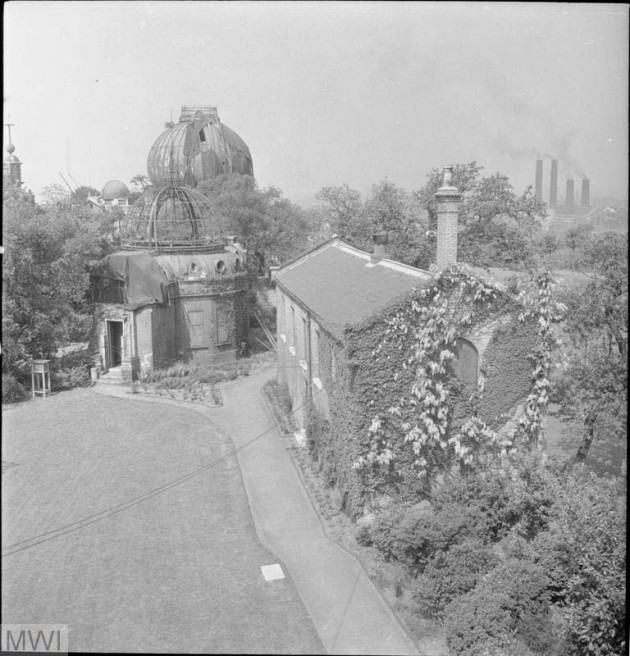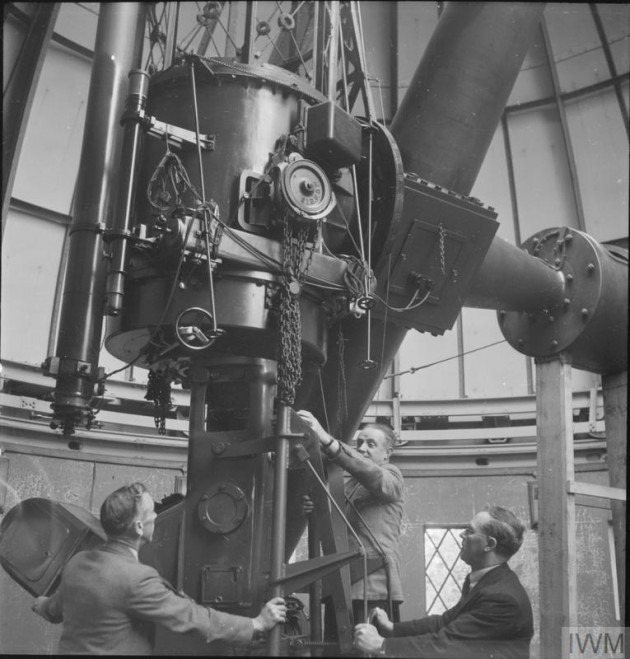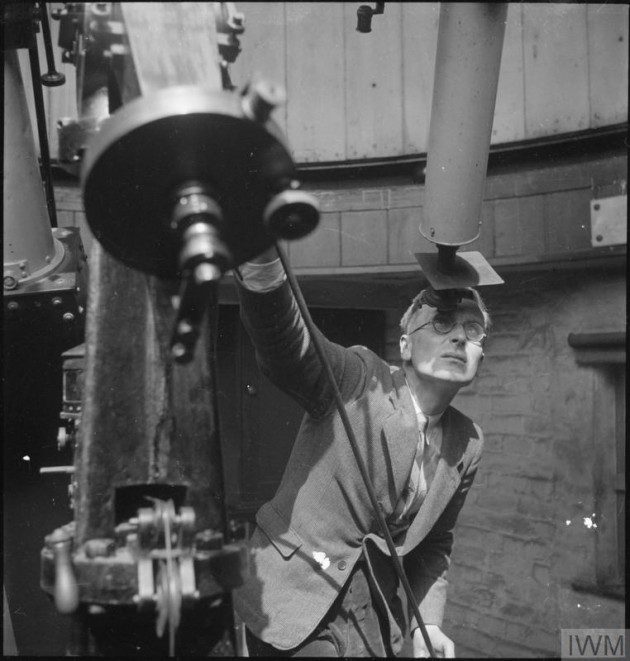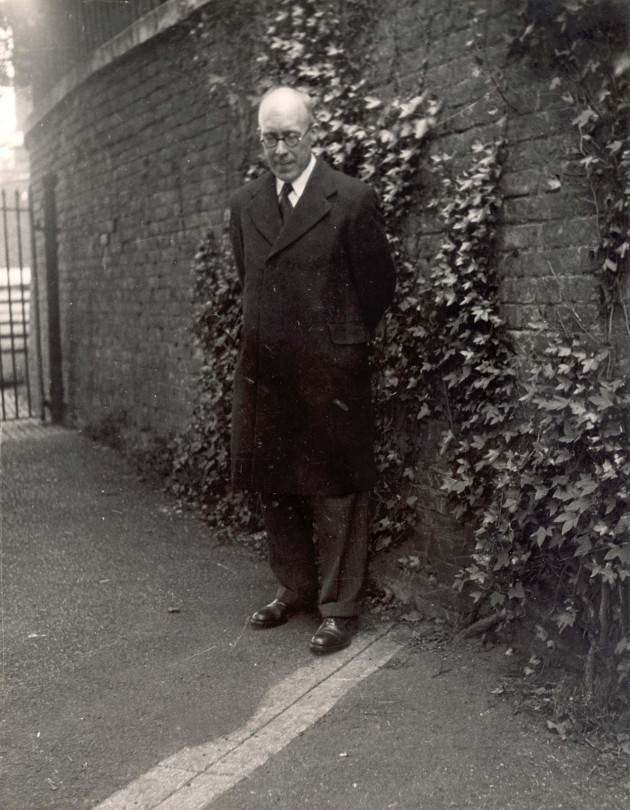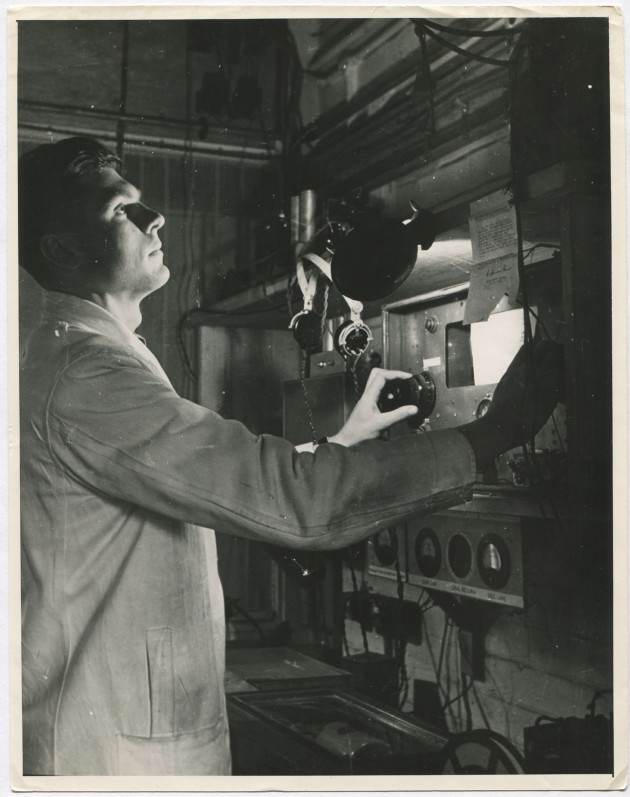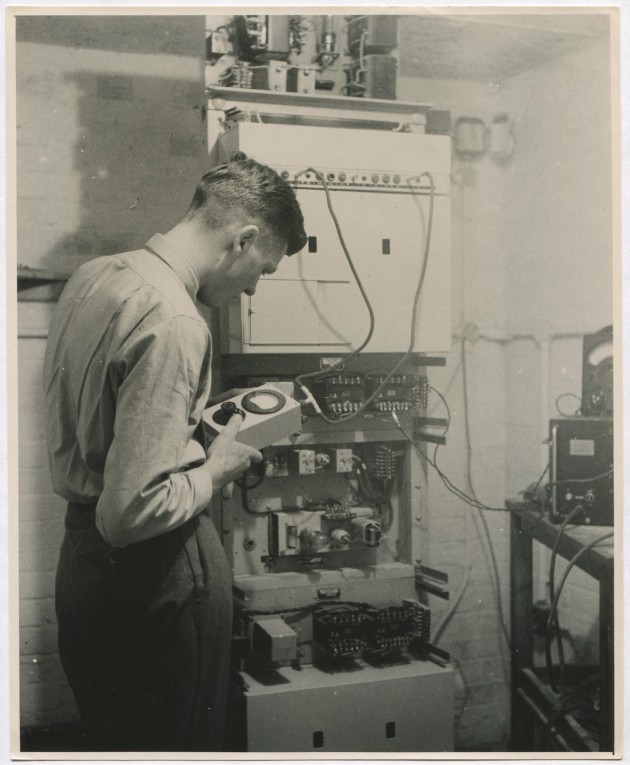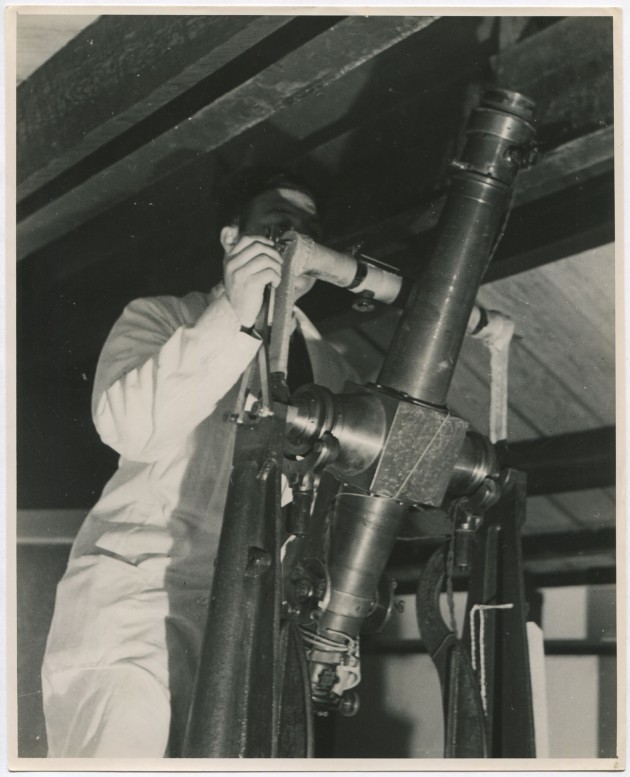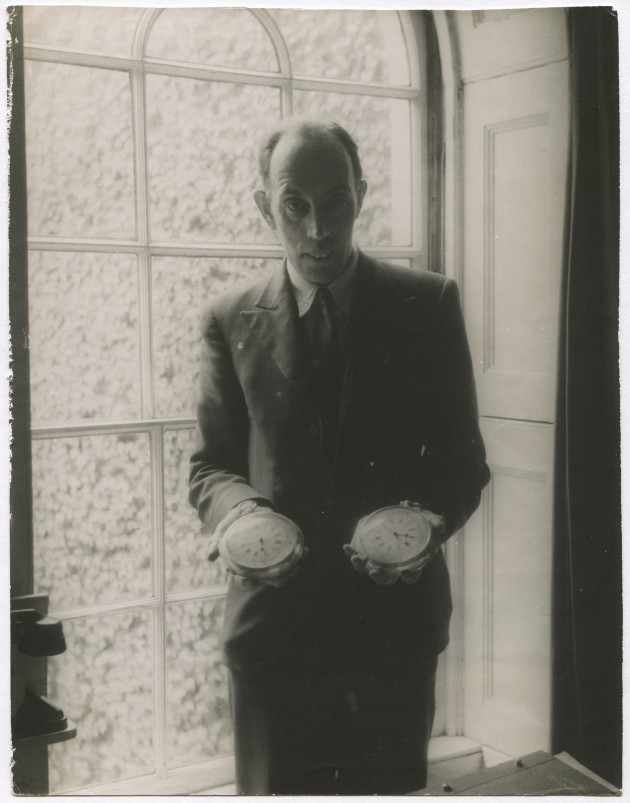…where east meets west
- Home
- Brief History
- The Greenwich Meridian
- Greenwich
(1675–1958) - Herstmonceux
(1948–1990) - Cambridge
(1990–1998) - Outstations (1822–1971)…
- – Chingford (1822–1924)
- – Deal
(1864–1927) - – Abinger
(1923–1957) - – Bristol & Bradford on Avon
(1939–1948) - – Bath
(1939–1949) - – Hartland
(1955–1967) - – Cape of Good Hope
(1959–1971)
- Administration…
- – Funding
- – Governance
- – Inventories
- – Pay
- – Regulations
- – Royal Warrants
- Contemporary Accounts
- People
- Publications
- Science
- Technology
- Telescopes
- Chronometers
- Clocks & Time
- Board of Longitude
- Libraries & Archives
- Visit
- Search
The Cecil Beaton photographs (1945)
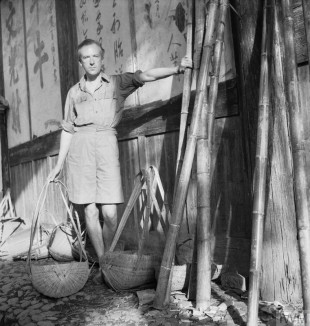
Cecil Beaton. Self-portrait taken in Puncheng, south eastern China during the Second World War. � IWM (IB 4287C)
Towards the end of the war, at the Ministry’s request, Beaton ‘made a photographic survey of the work of the various departments of the Royal Observatory’ This was reported by the Astronomer Royal to the Board of Visitors in his 1945 Annual Report (p.26).
Although Beaton is understood to have visited all of the Observatory sites (Greenwich, Abinger, Bath and Bradford on Avon) it is not known how many photos he took in total. According to records at the Imperial War Museum, 31 images were given serial numbers by the Ministry of Information and retained. It is not known how many of these were eventually released as prints.
Of the ten existing images so far identified (and reproduced below), just eight are known to exist as prints. The table below lists the sequence of serial numbers, and where information is available, the shot locations and a second number printed on the reverse of the prints (the series number?).
Serial Number |
Type* |
Location |
Subject |
People |
Series Number? |
||
| 1 | D.24696 | ||||||
| 1 | D.24697 | P&N | Greenwich | Flamsteed House | None | 2 | |
| 2 | D.24698 | ||||||
| 3 |
D.24699 | P&N | Greenwich | Solar Dome & Veg Garden |
None | 5 | |
| 4 |
D.24700 | P | Greenwich | Gt. Equatorial & Altaz. Domes |
None | 4 | |
| 5 |
D.24701 | N | Greenwich | Yapp Reflector |
E.Martin? + 2 |
n/a** | |
| 6 |
D.24702 | ||||||
| 7 |
D.24703 | N | Greenwich | Photoheliograph |
P. Laurie | n/a** | |
| 8 |
D.24704 | ||||||
| 9 |
D.24705 | P | Greenwich | Meridian Line | H. Newton | 6 | |
| 10 | D.24706 | P | Abinger | Radio receiver (time signals) |
J. Pope | 11 | |
| 11 | D.24707 | ||||||
| 12 | D.24708 | P | Abinger | Quartz Clock |
J. Pope | 13 | |
| 13 | D.24709 | P | Abinger | Small Reversible Transit Telescope B |
V. Barocas | 14 | |
| 14 | D.24710 | ||||||
| 15 | D.24711 | ||||||
| 16 | D.24712 | ||||||
| 17 | D.24713 | ||||||
| 18 | D.24714 | ||||||
| 19 |
D.24715 | ||||||
| 20 | D.24716 | P | Bradford on Avon | Chronometers H4 & K1 |
G. Rickett | 27 | |
| 21 | D.24717 | ||||||
| 22 | D.24718 | ||||||
| 23 | D.24719 | ||||||
| 24 | D.24720 | ||||||
| 25 | D.24721 | ||||||
| 26 | D.24722 | ||||||
| 27 | D.24723 | ||||||
| 28 | D.24724 | ||||||
| 29 | D.24725 | ||||||
| 30 | D.24726 | ||||||
| 31 | D.24727 |
* P=print, N=negtive
** information not available
Although the negatives are all believed to have been roughly square, the images appear to have been released as prints in a roughly 10 x 8 inch format. It is not known who was responsible for the cropping. Very few copies of the prints are known. Some have white margins, others do not. Those without are all slightly smaller in size and were previously owned by George Ricket. It seems possible that they did orignally have margins, but that they were trimmed off by Rickett for his own reasons.
Each print (as originally published) has two labels glued to the back (produced with a spirit duplicator). The first is generic and common to all. The second gives details of the specific image and also contains a second number (possibly its number in the Observatory series). The generic text existed in at least two different typed versions. Although the same wording was used, there are variations in layout as well as in typos. The text (corrected for typos) reads as follows:
British Official Photograph: Distributed by the Ministry of Information
The Royal Observatory.
The Royal Observatory at Greenwich was founded in 1675 for the practical purpose of assisting navigation and in particular to discover a method of finding the longitude at sea. The Rev. John Flamsteed, first Astronomer to hold office, received a Warrant from Charles II in 1675 appointing him “Our Astronomical Observer” at a salary of £100 a year, out of which he had to find instruments and assistants. The Observatory, built by Sir Christopher Wren on the hill at the Royal Park at Greenwich, was opened a year later. It had cost £520, the money being provided by the sale of spoilt gunpowder. Throughout its long history, the observations of the positions of the Sun, Moon, Planets and fixed stars had formed a principle part of the work of the Observatory, together with the determination of time and its distribution to the public; its close relations with the Admiralty endure to this day. In 1939 on the outbreak of war, the Observatory’s valuable transit instruments were dismantled and most of the departments and staff evacuated to various parts of the country, where, in Army huts, temporary Admiralty Offices and requisitioned private house, work has continued for nearly six years.
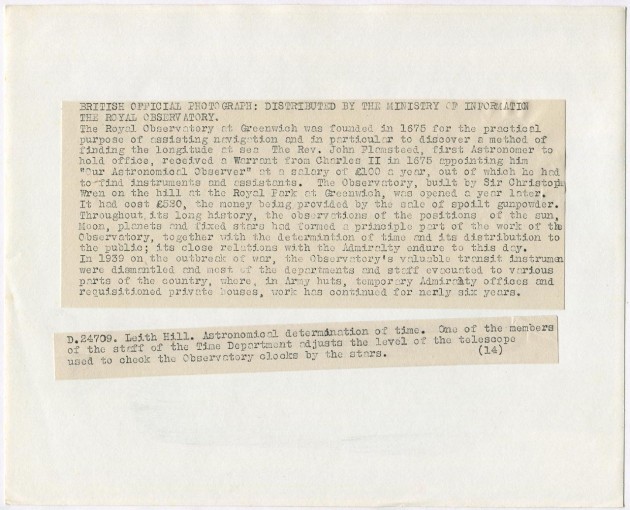
An example of the labels on the rear of the prints. The top label is generic. The bottom one is specific to the particular image (in this case, image D.24709). The bottom label also carries a second number, possibly a series number (in this case, 14). Humphry Smith Photographic Archive
It is believed that the four images available online in the collections of the Imperial War Museum (IWM) are scans taken from the original negatives. As displayed on the Museum’s website and reproduced here under the terms and conditions of the IWM Non Commercial Licence, they are described as being made of nitrate (cellulose nitrate having first been used as a base for photographic roll film from the late 1880s and continuing to be used for photographic and professional 35mm motion picture film until the 1950s – it is highly flammable and also decomposes with age, becoming toxic (click here to read more)). The scans are roughly square and show details that are absent in the cropped 10 x 8 inch prints. Although the serial numbers are given, the accompanying text is not the same as that on the equivalent print, suggesting that it was written my an IWM staff member, but using some text from the Ministry of Information. All the images have a black border and one of the images (D.24700) is also flipped. This together with their proportions and the material they are made of suggests that the four IWM images were indeed created directly from the negatives rather than from a published print (they are also all are slightly skewed). Further enquiries as to the exact extent of the Imperial War Museum’s holdings are currently underway.
Serial Number |
D.24697 | ||
Series Number? |
2 | ||
Dimensions |
Top: Print approximately 9 x 7.5 inches (probably cut down from 10 x 8 inches). Bottom: IWM image (dimensions unknown) | ||
Location |
Greenwich | ||
Published Caption |
Greenwich. Part of the old Wren building, the original Observatory. On the roof are wind recording instruments and the Time Ball. This first public time signal was introduced in 1833 when the Admiralty issued the following notice – “The Lords Commissioners of the Admiralty hereby give notice that a Ball with henceforward be dropped every day from the top of a pole on the Eastern Turret of the Royal Observatory at Greenwich at the moment of one o’clock p.m. mean solar time. By observing the first instant of its downward movement, all vessels in the adjacent Reaches of the river, as well as in most of the Docks, will thereby have an opportunity of regulating· and rating their Chronometers.” This time signal was given daily right up to the outbreak of war. Flamsteed House, in the foreground is in peace-time the residence of the Astronomer Royal. The 1940 Blitz is responsible for the absence of glass in all the windows. Many bombs fell around the Observatory during the raids but although much damage was done, all. Observatory officials are agreed that it was only by the greatest of good luck that it wasn’t infinitely worse. |
||
IWM text |
The Royal Observatory Greenwich: Everyday life at the Royal Observatory, Greenwich, London, England, UK, 1945 (D 24697) A view of Flamsteed House, part of the old Observatory building designed by Sir Christopher Wren. Clearly visible in the top right hand corner is the time ball, which, since 1833 until the outbreak of the war, had given a time signal to ships in the Thames nearby by dropping at one o’clock in the afternoon. Also clearly visible is the damage to the building caused by the 1940 Blitz: the lower part of the building has no glass in the windows. Copyright: © IWM. Original Source: http://www.iwm.org.uk/collections/item/object/205201920 | ||
People |
n/a |
||
Further Information |
– | ||
Image Source |
Top: George Rickett Photographic Archive. Bottom: Imperial War Museum © IWM (D 24697) |
Serial Number |
D.24699 | ||
Series Number? |
5 | ||
Dimensions |
Print approximately 9.1 x 7.5 inches (probably cut down from 10 x 8 inches) | ||
Location |
Greenwich | ||
Published Caption |
The Astronomer Royal’s garden. This old walled garden with its espalier fruit trees and flower-covered terraces seems as if it is in the heart of the country. Wren built the Observatory on the site of an old Watch Tower, but most of the stones and bricks come from a fort at Tilbury that was pulled down at that time. The building on the right with vertical shutters houses the famous Airy Transit Circle which defines the Greenwich meridian. The Wren buildings are on the left. |
||
People |
n/a |
||
Further Information |
The dome in the centre was erected in 1844 to house the Observatory’s new Altazimuth Telescope. By 1911, the telescope was redundant and one of the Dallmeyer Photoheliographs was installed there instead for daily observation of the Sun. It remained in use throughout the war. Behind it and slightly to the left is the dome of the Astrographic Telescope (erected in the late 1880s). Note the bricked up windows of the Time Department control room to the right of the old Altazimuth Dome. |
||
Image Source |
George Rickett Photographic Archive |
Serial Number |
D.24700 | ||
Series Number? |
4 | ||
Dimensions |
Top: Print digitally cropped to approximately 9.5 x 7.3 inches and reproduced as a grayscale image. Bottom: flipped IWM image (dimensions unknown) |
||
Location |
Greenwich | ||
Published Caption |
War damage at the Observatory. Looking North from the Main Building[.] In the middle distance is the Altazimuth building erected at the end of the last century to house a reversible transit circle with an 8” object-glass and circles of 3 feet in diameter for extra-meridian observations of the moon. Beyond it is the Oriental Looking Dome built to house a 28” refracting telescope provided by the Admiralty in 1886. Both buildings and the reversible transit instrument were badly damaged by a bomb which fell between them one night in the autumn of 1940, though the main damage to the Oriental Dome was caused by a flying bomb in August 1944. |
||
IWM text |
The Royal Observatory Greenwich: Everyday life at the Royal Observatory, Greenwich, London, England, UK, 1945 (D 24700) A view of bomb damage to various buildings at the Royal Observatory, Greenwich, taken looking north from the main building. In the middle distance is the Altazimuth building, and in the background is the Oriental Dome. Both buildings were damaged by a bomb in Autumn 1940, but the Oriental Dome was also damaged by a flying bomb in August 1944. Copyright: © IWM. Original Source: http://www.iwm.org.uk/collections/item/object/205201921 | ||
People |
n/a |
||
Further Information |
The caption as published is both misleading and incorrect in places. Christie's Altazimuth Telescope (which was a modified version of a reversible transit circle) was dismounted at the outbreak of the Second World War and replaced with a small reversible transit telescope. It was this second instrument that was damaged (though not seriously) in the war. The building on the right was constructed by Airy as a New Library. However, by 1914, the library had been relocated and the building was put into use as a store. The bomb did not fall as impled between the Altazimuth building (Pavilion) and the Oriental Dome (the Great Equatorial Building). A clearer description of what happened in 1940 was given by the Astronomer Royal in his 1941 Report to the Board of Visitors. In it, he made the following statement: ‘The buildings have received damage on several occasions by enemy action, The north wing of the Main Building [the 920]and the south portico of the Altazimuth building have both received direct hits from bombs; the damage, though considerable is not serious. The main gates and supporting pillars have been destroyed by a direct hit, when most of the covered way in the courtyard was also destroyed. There has been extensive damage to windows, window frames and ceilings throughout the Observatory. The coverings of the altazimuth and transit pavilion domes have been destroyed and those of the 28-inch refractor and 26-inch refractor domes have been riddled with holes by fragments. The Cooke small transit instrument was broken in half when thrown from its mounting in the altazimuth domes though the object glass was undamaged. The Cookson telescope received minor damage when the exposing shutter above the instrument was detached by blast and dropped on the telescope. The large lenses, mirrors, and some other valuable parts of the principal instruments have been sent away from Greenwich for safety. No structural repairs to damaged buildings have been made, but temporary repairs have been carried out.’ |
||
Image Source |
Top: Private Collection. Bottom: Imperial War Museum © IWM (D 24700) |
Serial Number |
D.24701 | ||
Series Number? |
Information not available | ||
Dimensions |
IWM image (dimensions unknown) | ||
Location |
Greenwich | ||
Published Caption |
Information not available |
||
IWM text |
The Royal Observatory Greenwich: Everyday life at the Royal Observatory, Greenwich, London, England, UK, 1945 (D 24701) Maintenance engineers adjust a spectroscope at the Royal Observatory, Greenwich. The telescope was presented to the Observatory in April 1934 by Mr Johnston Yapp to commemorate the services of the Astronomer Royal, Sir Frank Dyson, who retired in 1933. It was made by Sir Howard Grubb of Parsons and Co., and has been largely dismantled as a wartime measure. Copyright: © IWM. Original Source: http://www.iwm.org.uk/collections/item/object/205201922 | ||
People |
E.G. Martin? (right) + 2 unidentified |
||
Further Information |
The image shows three individuals (presumed to all be staff members) apparently working on the spectroscope attached to the Yapp telescope at Greenwich. The telescope and spectroscpoe are shown in the process of being recomissioned after having been mothballed during the war. The weight of the telescope and spectroscope was normally counterbalanced by the large weight that can be seen on the right. In this image it is supported by a wooden framework as the telescope would have been significantly out of balance if the spectroscope had been previously detached. |
||
Image Source |
Imperial War Museum © IWM (D 24701) |
Serial Number |
D.24703 | ||
Series Number? |
Information not available | ||
Dimensions |
IWM image (dimensions unknown) |
||
Location |
Greenwich | ||
Published Caption |
Information not available | ||
IWM text |
The Royal Observatory Greenwich: Everyday life at the Royal Observatory, Greenwich, London, England, UK, 1945 (D 24703) A scientist at the Royal Observatory, Greenwich, waits for a break in the clouds to take a photograph of the sun, using a haliograph [photoheliograph]. According to the original caption, this has occurred daily, weather permitting, since 1873 and ‘the photographs are measured to obtain the areas and positions of the spots and other markings on the Sun, thus providing a continuous records of the Sun's activity’. Copyright: © IWM. Original Source: http://www.iwm.org.uk/collections/item/object/205201923 | ||
People |
Philip Laurie |
||
Further Information |
The image shows Philip Laurie at work with the Dallmeyer Photoheliograph which was installed in 1911 in the old Altazimuth Dome (see image D.24699 for an external view) for daily observation of the Sun. Unlike the larger telescopes which were mothballed, the photoheliograph remained in use throughout the war. | ||
Image Source |
Imperial War Museum. © IWM (D 24703) |
Serial Number |
D.24705 | ||
Series Number? |
6 | ||
Dimensions |
Digitally cropped to approximately 9.6 x 7.5 inches | ||
Location |
Greenwich | ||
Published Caption |
Mr H.W.Newton, Assistant-in-charge standing by the Greenwich Meridian. On a publ footpath outside the Observatory, Zero meridian is indicated by a long stone inset. In 1884 at a conference in Washington at which most countries were represented, by an almost unanimous vote the meridian through the centre of the Airy transit instrument of the Greenwich Observatory was adopted as the Zero or Prime meridian from which longitudes should be measured thoughout the world. |
||
People |
H.W. Newton (Junior Assistant (Higher Grade) & Officer-in-Charge of the Greenwich site, the Astronomer Royal having been evacuated to Abinger for the duration of the war). |
||
Further Information |
– | ||
Image Source |
Private Collection |
Serial Number |
D.24706 | ||
Series Number? |
11 | ||
Dimensions |
Approximately 10 x 8 inches | ||
Location |
Abinger | ||
Published Caption |
Leith Hill. After the outbreak of War the Time Department of the Observatory was evacuated to Leith Hill in Surrey where the Magnetic Ob Observatory had been situated since 1923. Here is a member if the staff tuning-in to a radio time signal. A regular check is made on British and foreign time signals. |
||
People |
John Pope (Temporary Observing Assistant) | ||
Further Information |
– | ||
Image Source |
Humphry Smith Photographic Archive |
Serial Number |
D.24708 | ||
Series Number? |
13 | ||
Dimensions |
Approximately 10 x 8 inches | ||
Location |
Abinger | ||
Published Caption |
Leith Hill. Checking the performance of one of the new quartz ccrystal clocks now being installed in the Time Department. This type of clock consists essentially of a quartz crystal maintained in vibration by electrical means – about 100,000 a second – counted by special methods. It is intended, when additional clocks of this type have been installed, that quartz crystal shall ultimately replace pendulum clocks as the standard clocks of the Observatory. With the aid of these clocks and other technical refinements the 24 hour time signal is now given in rhythmic time-signal with a maximum error of a few thousandths of a se second. |
||
People |
John Pope (Temporary Observing Assistant) | ||
Further Information |
– | ||
Image Source |
Humphry Smith Photographic Archive |
Serial Number |
D.24709 | ||
Series Number? |
14 | ||
Dimensions |
Approximately 10 x 8 inches | ||
Location |
Abinger | ||
Published Caption |
Leith Hill. Astronomical determination of time. One of the members of the staff of the Time Department adjusts the level of the telescope used to check the Observatory clocks by the stars. | ||
People |
Vinicio Barocas(Temporary Observing Assistant) | ||
Further Information |
The telescope is the Small Reversible Transit B originally purchased for the 1872 Transit of Venus expeditions, but here used for determining clock errors. |
||
Image Source |
Humphry Smith Photographic Archive |
Serial Number |
D.24716 | ||
Series Number? |
27 | ||
Dimensions |
Approximately 9 x 7 inches (probably cut down from 10 x 8 inches) | ||
Location |
Bradford-on-Avon | ||
Published Caption |
Bradford-on-Avon. Mr Rickett, Assistant-in-charge, holds in his hands Harrison’s time-keeper with the duplicate which, in accordance with the terms of the award, was completed by Larcum Kendal in 1769. This was used by Captain Cook on his famous voyage on the “Endeavour.” |
||
People |
George Rickett (Junior Assistant (Higher Grade) & Officer-in-Charge of the Bradford-on-Avon site) | ||
Further Information |
In January 1941, Lynchetts, a private house in Woolley Street, Bradford on Avon, was requisitioned for use by the Observatory. The photo was taken in front of one of the arched windows at the front of the house (probabaly the one on the first floor above the entrance). Harrison’s H4 (left) and the Kendall’s copy K1 (right), were sent to Lynchetts in 1945 for an overhaul and cleaning. It was while there that their cases were rhodium plated. | ||
Image Source |
George Rickett Photographic Archive |
© 2014 – 2025 Graham Dolan
Except where indicated, all text and images are the copyright of Graham Dolan
